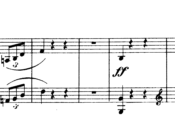Analysis
Contents
Prelude
SUMMARY:
Bars 1-21: Period I. Establishes Tonic key, E minor, and visits Relative Major in Bars 4-9. Touches E minor and C major (in a sequence in Bars 9-10), as well as A minor (Bar 14). Gradually returns to E minor to end with a Perfect Cadence in the Tonic.
Bars 21-23: Episodal. Modulating to the Sub-dominant, A.
Bras 23-41: Period II. Presto. Touches A minor and C Major (Bars 27-29) before returning to E minor.
REMARKS:
Period I has two subdivisions, the first at Bar 4, the second at Bar 9.
The style of Period I is that of a solo accompanied by as persistent figure; and it is indeed easy to imagine to solo being played by a Violin or Flute, accompanied either by the under-strings or a Piano.
Period II, starting with a change of tempo, is in two parts only as far as Bar 34, then a third part is added, and finally it concludes in four-part harmony. The material used in the construction of this Period is mainly drawn from the figure used as an accompaniment (in the left hand) of the opening bars of the Prelude.
In this Prelude fresh artistic devices are built upon one another, showing in fact the super-position of the Florid Instrumental Cantilena above the basis of the typical figures and chains of chords as seen in Preludes I and II, while in its elaborate and impassioned Recitative work it is, in affinity of principle, closely allied to Prelude VIII.
Fugue
ANALYSIS:
ENUNCIATION SECTION:
Bars 1-3: Subject in Treble, ending on the second quaver of Bar 3 [E minor].
Bars 3-5: Real Answer in Bass. Counter-subject in Treble [B minor].
MODULATORY SECTION:
Bars 5-11: Episode I, modulating from B minor to G major.
Bars 11-13: Subject in Treble. Counter-subject in Bass [G major].
Bars 13-15: Answer in Bass. Counter-subject in Treble [D major].
Bars 15-20: Episode II, modulating from D major to A minor.
Bar 20-22: Subject in Bass. Counter-subject in Treble [A minor].
Bars 22-25: Answer in Treble. Counter-subject in Bass [E minor].
Bars 25-30: Episode III, modulating from E minor, through G and A, to D minor.
Bars 30-32: Subject in Bass Counter-subject in Treble [D minor].
Bars 32-34: Answer in Treble. Counter-subject in Bass [A minor].
Bars 34-38: Episode IV, modulating from A minor to G major in thirty-seventh bar, and a sudden wrench back to E minor in the thirty-eighth bar.
RECAPITULATORY SECTION:
Bars 39-40: Fragment of Subject in Treble and of Counter-subject in Bass [E minor].
Bars 40-41: Fragment of Subject in Bass [E minor].
Bars 40-42: Coda. Imitation of the last part of Subject in Treble [E minor].
SUMMARY:
Exposition: Bars 1-5.
Counter-exposition: None.
Stretti: None.
Episodes: Four.
Coda: Bars 40-42.
REMARKS:
- This Fugue is in two parts. It has a “real” Answer and would be styled as a “real” Fugue.
- Two passages in octaves occur: one at Bars 19-20, the other at Bars 38-39. Such passages are not often found in two-part compositions of this class. The first of these marks the point where the balancing second half of the Fugue begins, and the second emphasizes the return to the original key at the conclusion.
- All the Episodes are composed of the same materials, and an examination of them will show that Episodes III and IV are inversions of Episodes I and II.
- This Fugue is of very regular construction, being manifestly in two equal halves, the second half from Bar 20, being a transposed inversion of the first half, with short Coda. Moreover, the alternation of passages concerned with Subject matter and Episode is remarkably regular, and the length of each nearly invariable throughout.








